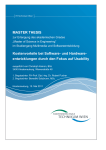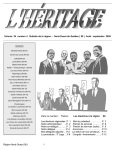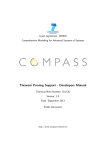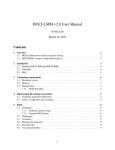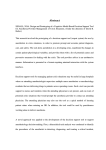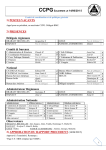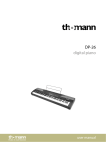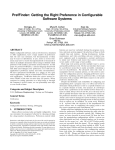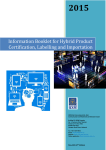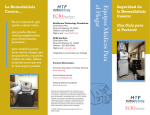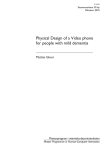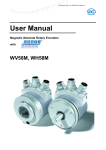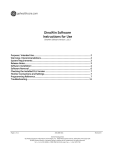Download How humans factor (in medical device design)
Transcript
M AA 2 r te ct af it O ed is mm ev u R AS D I/F How humans factor (in medical device design) by Fiona Theobald and Matthew Theobald 01 3 How humans factor (in medical device design) How humans factor (in medical device design) By Fiona Theobald and Matthew Theobald Second Edition – revised and updated after AAMI/FDA Summit on Home Healthcare, October 2013 Copyright © 2013 Fiona Theobald and Matthew Theobald All rights reserved. Cover design by Three Circles Book design by Three Circles No part of this book can be reproduced in any form or by written, electronic or mechanical, including photocopying, recording, or by any information retrieval system without written permission in writing by the author. Published by Three Circles Printed by Book Printing UK www.bookprintinguk.com Remus House, Coltsfoot Drive, Peterborough, PE2 9BF Printed in Great Britain Although every precaution has been taken in the preparation of this book, the publisher and author assume no responsibility for errors or omissions. Neither is any liability assumed for damages resulting from the use of information contained herein. 2 A First Word...........................................................................4 Usability FMEA................................................................25 Why Humans Factor..............................................................5 Planning...........................................................................26 When things go wrong.......................................................7 Device Testing.................................................................27 What is Usability?................................................................10 Usability Tests..................................................................28 Iterative Testing................................................................29 Usability Strategies..............................................................11 What to test?....................................................................30 Base Jumping..................................................................12 Validation.........................................................................32 Fell Running.....................................................................13 Human Factors Engineering file......................................34 Understanding the users.....................................................14 After launch.........................................................................34 How to build your Usability programme...........................14 People do surprising things.............................................15 What's Next?.......................................................................35 A bit about different ways people think............................16 Further reading....................................................................36 User Research.................................................................17 A development route map (large)........................................37 Use Scenarios.................................................................19 A Final Word........................................................................38 Concept Generation........................................................20 A development route map....................................................21 Considering risk...............................................................22 Usability Specification......................................................23 About Fiona.........................................................................39 About Matthew.....................................................................39 About Three Circles.............................................................40 3 How humans factor (in medical device design) Contents How humans factor (in medical device design) A First Word Have you ever walked over to the kitchen hob, pressed a button and lit the wrong ring? Have you ever struggled with doors and pushed when you should have pulled? Have you flashed your windscreen wipers in annoyance at another road user? If, like us, you’ve experienced any of these things, you’ll finish this book understanding why its important to get design right. This book is about changing the way you look at design, sharing the importance of understanding what your product's users need of it. Its a consideration that's becoming increasingly visible, as healthcare regulatory authorities around the world expect to see it's results in medical device and combination product approval submissions. We've revised the content to reflect the latest thinking from both industry and the FDA, as discussed during the AAMI/FDA home healthcare summit in October 2013. As you read, you will discover what should be taken care of at the outset and how this pays dividends later on. What we're going to do is help you see why its important to get design right for a medical device. You may then think about how you’re going to use this approach. We hope you enjoy your journey Fiona and Matthew, October 2013 4 How humans factor (in medical device design) Why Humans Factor A few years back, Fiona worked for a pharmaceutical company where they had installed a new manufacturing line. The man responsible for designing the line, a very clever man, didn’t believe in over mechanising a system, so kept it simple by using gravity to help liquid flow through the line. Size was also an issue during a concept generation exercise for a new pen injector. A few of the designers insisted on creating a pen which was very small, and proceeded to generate a functioning small concept model. They were following the same evolutionary idea as the miniaturisation of mobile phones. As part of the cleaning validation we had to identify hard to clean areas. On her first visit to the line, Fiona was a little taken aback to see the operators equipped with hard hats and a step ladder. An interested client liked the look of the pen, but asked if they could “make the design bigger as their customers were likely to find the device too small and fiddly”. The pipe work under the vessels looked like a chemical plant maze. To access the vessels the operators had to duck and weave around a network of metal pipes – hence the hard hats. To cap it all one of the water sample points was over six foot up in the air. Remember when all you could do with a mobile phone was text and make calls? Then predictive text came, to make our lives “easier”. The design might make more sense if we told you the design engineer was over six foot tall and the pipe installation engineer was a very thin and wiry, about 4 foot 9 inches. When Fiona got her first mobile with predictive text, Matthew asked why she was only sending very short, abrupt messages, had he done something wrong? No, Fiona just couldn’t override the predictive text and her messages were becoming garbled rubbish, so she cut the content down to the absolute minimum. 5 How humans factor (in medical device design) We couldn’t find the menu to disable the predictive text function. So how do humans factor in medical device design (and more widely in design)? It may seem obvious when you think about it, but it's surprising how often we (the users) are forgotten in the rush to create a “sexy” device. 6 How humans factor (in medical device design) When things go wrong You may be wondering what happens when humans are not considered in the design process. We'd like to share a few examples that may help you see the harms that can arise. According to the US Food and Drug Administration: “One third of medical device reports each year involve useerror and human factors are inherent in virtually all devicerelated incidents.” Only when things start to go wrong do people ask; • What was missed during the design process? • Why did they do that? • Were the instructions not clear? • Did we not give them the right equipment? Human Factors Engineering of medical devices (also described as Usability) focusses on answering these questions, by checking: • Is the device fit for purpose? • Is it safe to use? • Does it give the user the right tool? Sadly the answer to these questions is often NO. 7 How humans factor (in medical device design) 20% of medical device errors are due to mechanical failure, according to the Institute of Medicines ( IOM 2000 and Perrow. 1984). We spend a lot of time during development testing our devices to ensure the build quality is robust and that the performance is acceptable. But 80% of these failures are due to human error. It is very easy to dismiss human error as stupid mistakes or to think that the users “need more training”. However, studies have found that contrary to blaming users, many errors are caused partly by poor device design; failing to account for the needs of users. Susan Gardner from the FDA has said “The problem usually isn't that the device broke, rather it wasn't intuitively user-friendly, or the user didn't have instructions on hand or didn't know about a change in the way the device was to be used in a certain setting” 8 Most of these errors can be associated with human error, mishaps or at worst negligence. In the USA, the FDA and Health & Human Services recognise Human Factors as a priority, particularly for medical devices used outside of hospital environments. It boils down to developing a device that is simple to use, “just makes sense”, one that will work in a challenging environment, with consistent and understandable user interfaces. Over the course of this book we're going to take a look at what Usability is, Usability strategies we've witnessed and the ones we have seen work. Then we need to think about who the device is intended for, who are these users, what makes them tick? Lastly we'll look at how Usability fits with the device development process. Usability supports all five points of their strategy for home healthcare. The message was clear at the October 2013 AAMI/FDA summit on home healthcare; Starting Human Factors activities early, to understand users and caregivers real needs, is fundamental to overcome most issues with using medical devices. So, it is clear that usability must start at the very beginning of design and consider all aspects of the device, supplies, training and other materials. 9 How humans factor (in medical device design) The bottom line is that 98,000 patients die annually in American hospitals as a result of medical errors. How humans factor (in medical device design) What is Usability? Before we get into the detail, let's clarify what usability is about. Many people ask “isn’t usability something market research do?” Well no, not in our experience. Market research tends to examine device features, pricing and serviceability. The research is driven by statistical power requirements and test hundreds of people in multiple countries, looking at peoples' perceptions and preferences. It isn't industrial design research either, although sometimes people confuse the two. Industrial design creates product designs that focus on form, physical ergonomics, marketing and brand development. In Human Factors we are looking to see if a device is safe to use, looking for use errors and user interface design problems. When you get the response “that was easy to use” after having watched a participant struggle for 5 minutes to use your prototype device, you have to question 10 what is really going on. Usability studies have shown that after testing with just a handful of people, the most severe use errors are likely to be revealed. “It's about good product design, not just a regulatory hurdle to be overcome” Joseph Cafazzo, AAMI/FDA summit Oct 2013. And because Usability is primarily looking at safety, regulators throughout the world increasingly expect this type of testing and evaluation. There is the added benefit that if you deliver a good product, fit for purpose that pleases your customers, it is likely to increases sales and reduce customer complaints. How humans factor (in medical device design) Usability Strategies Now we're on the same page about what Usability is, let's take a look at strategies for Usability. The ISO 62366 standard has a very detailed process of how to develop your Usability strategy. The standard also explains how a Usability strategy links with your Risk Management process. The links reinforce the safety aspects that you are looking to address or incorporate in your product design. As with many things in life, the strategy you choose becomes a matter of how much risk you are prepared to live with; • • How comfortable are you with the risk of meeting a costly surprise if you choose to test late in development? How much risk are you prepared to pass onto your customers, your users? Lets take a look at two strategies to incorporate usability into a medical device development project. 11 How humans factor (in medical device design) Base Jumping The dare devil approach. It's a high risk strategy that is often seen as the fast way of getting down the mountain. For this strategy to succeed, the device manufacturer has to be super confident in their design, either because it is very similar either a design they have already done or it is very similar to what’s already on the market. In this scenario Usability testing is done at the last possible stage, when the design is frozen and the company is ramping up for launch. Sometimes, testing is even done after launch when the regulators ask for the Human Factors Engineering file. To take on this strategy you have to have a lot of confidence that your customers (and ultimate users) know how to work your device as well as you do. After all, “Its not the fall that kills you”. 12 How humans factor (in medical device design) Fell Running This approach is often perceived as slowing down a fast track project. The strategy includes Usability activities throughout the various stages of product development. It's the more conventional way of getting down a mountain. “The sooner HF gets involved, the quicker, cheaper development is” Vicki R Lewis, AAMI/FDA summit 2013. In reality adding Usability activities to a project should not impact on time-lines, as activities can run in parallel with more conventional lab and physical testing. Indeed, these activities will greatly reduce the likelihood of expensive redesigns or fire-fighting as you get closer to scale-up and launch preparation. Of course, Usability activities need to be budgeted for, but; • How much expensive is unfreezing a design to start developing new mould tools? • How much more expensive is a product recall because of a foreseeable use error? Taking this approach should not end messily, as you descend your mountain. 13 How humans factor (in medical device design) Understanding the users Let's move to thinking about how to build your Usability programme, to achieve the benefits we've talked about already. The key thing here is to understand the intended use of your device and a big part of this is understanding your users. How to build your Usability programme There are five fundamental questions that your Usability programme should be designed to answer; 1. Who are you making the device for, 2. Do you really know what they need, what their capabilities are? 3. When will people be using your device, 4. Where will they be? 5. How will they use it? Or, are you assuming that; as we are all human, we all think alike, so we must all want the same thing? Usability is about checking that we have made the right assumptions. It checks the assumptions with real users to make sure we are starting our design based on factual evidence, not best guesses. 14 After all what either of us need from a device may be completely difference to what our daughter may need, or what the man down the street needs. How humans factor (in medical device design) People do surprising things One thing you can expect when you place your device into the hands of representative users is that people will do the oddest things with it, if they are not adequately informed. You would hope that this person was stopped before they did any damage! However, we've have witnessed a frail, little old lady, when asked to gently tap a device, suddenly bang it hard onto a surface to knock the air out breaking the glass cartridge. We have seen a man with big strong hands completely crumble an inhaler as he unknowingly twisted it the wrong way to activate it and then ask “is that ok?” Confident, happy people turn to gibbering wrecks when asked to follow a set of instructions that would have baffled Einstein. Or the one that still makes us cringe; a video of a lady who left several Type A insulin needles inserted in her stomach, believing they were supposed to be used like catheters. 15 How humans factor (in medical device design) A bit about different ways people think Let's take a moment... Think of an elephant. After all, we all know what an elephant should look like, right? How would you describe your elephant? Was it an African elephant, a pink cartoon one, a fluffy toy or a family group? When we ask people to think of an item, the image, feelings or sounds that come to mind depend on their personal experiences. 16 Before creating a slide for a conference presentation to illustrate this using injectors, it hadn’t even occurred to us that injectors belonged in engines too. A similar lack of situational awareness, in medical device use, is a major factor in human error. So assuming we know how people will think and behave when asked to perform a task can be very presumptive. You may have overheard the comment that “people are stupid” when you see some of the surprising things that they do. But given that we don’t all think alike, perhaps they were not adequately informed? How humans factor (in medical device design) User Research User research is about profiling the people likely to use our device, listing their characteristics, their likely thought process(es), capabilities and limitations. This research results in one or more User Profiles describing intended users, of which there may be more than one distinct group such as children and adults. Many people are needle phobic and yet we persist in developing devices with a needle showing. This is often countered by people who like to be able to see the needle, to know how far to push it in. Consumer devices (like smart phones, “health gadgets”, PVRs) bring new expectations and possibilities for medical devices, setting precedents for patients wanting the same for their treatment. On the other hand, we may expect that users are able to use a smart phone app, when they don't necessarily even have a mental model of how a smart phone works. 17 How humans factor (in medical device design) Many patients already experience a high burden from their disease (physical, cognitive, financial and emotional). Make sure your device doesn't increase this burden, through a fear of the device, embarrassment when using, frustration or complexity when using. On top of this, users make inappropriate assumptions about how a device works, or should be used, leading to workarounds and non-adherence, both of which lead to vulnerabilities for the user. These are exactly the types of Usability design challenges that should be accounted for early on when developing a new design. This is usually the bit most designers live for – meeting a new challenge and coming up with something novel. Interesting solutions are often created from problem statements like “an object that is seen when it needs to be and not seen when it doesn’t.” Meeting with users can often lead to aha moments that would not have come to mind otherwise. 18 How humans factor (in medical device design) Use Scenarios Now we know who our users are, we can start thinking about where they will be when they use the device. Examples of the places people may use the device (right). The likely Use Scenarios should be examined as part of any risk assessment or failure analysis, as they can contribute significant risks to device use. Users often make a trade off between comfort/quality of life and safety. We recently heard of a patient that stored and used their home dialysis machine on the balcony, with a patio heater to keep it warm. They valued the fresh air and view whilst undergoing treatment. So, use scenarios should include how/where the device will be really stored between uses. Consider too that user capabilities (e.g. alertness, motivation, attention) will vary in different scenarios . Another valuable consideration is scenarios that could result in device abuse. Situations with, for example, bright lights, low light, level, wet hands, lack of privacy. As more technology is used outside the clinical setting, different challenges arise, such as emergency planning for the patient, what do they do when there's a power cut? 19 How humans factor (in medical device design) Concept Generation At this point, we know who is going to be using our device and where they are likely to use it. We are starting to get a picture of the problems we will need to solve with our design. This is the fun stage, an excellent time for a brainstorm. We now possess a list of usability problems to solve. Its a lot easier to be creative with a list problems to solve than trying to start from a blank sheet of paper. User profiles and scenarios help to create good design solutions. One happy by-product is usually the creation of lots of design Intellectual Property (IP) based on our problem statements and their potential solutions. 20 When we have identified a design solution to take through development, Usability activities should be formalised as part of the subsequent process. We at Three Circles have mapped out a development route map to show the tracks and interactions that a typical development plan and team will take. 21 How humans factor (in medical device design) A development route map How humans factor (in medical device design) For example, there is the project manager who tracks the project, helping to tackle conflicts and issues as they arise. The designer who looks after the design and manufacturability of the device and also ensures that performance testing appropriately challenges the design. Amongst these disciplines should be the Human Factors or Usability experts, who work closely with the designer and risk manager, to name but two. Looking at the Human Factors track, the journey is based on the ISO 62366 process and reflects the practicalities of working within a multi-disciplinary team. Let's look at each step on the journey in turn, but first a bit about risk. Considering risk At some point, you'll need to incorporate risk into the design process, probably following ISO 14971 as you go. As we know the likely problems and we now have some potential solutions (concept designs), now is a perfect time to marry the two together and perform an FMEA (failure modes and effects analysis) but from a User perspective. We call this a Usability FMEA (uFMEA), more on the detail of this later on, suffice to say, the outputs of the uFMEA should inform and feed in to your risk assessments, updated with design mitigations as you go. Alongside drafting the uFMEA you'll usually be creating the first draft of Usability and product design specifications, which underpin subsequent test programmes. The uFMEA looks at the task analysis and potential risks, the Usability Specification specifies the design and what it needs to be able to achieve. 22 How humans factor (in medical device design) Usability Specification In conjunction with the design specification, this establishes the usability goals. In other words; what the user needs to be able to achieve when they come into contact with the device. Providing clear Usability rationales for design and usability goals helps to support design decisions. It is not unusual to encounter design specifications which had been set because they seemed like a good idea at the time, only for someone to challenge them later because the device didn’t quite meet the limits imposed. This often results in days of work justifying a change. Being able to apply some level of rationale to all design features helps provide understanding as to why they are important and what it means to our users. “Just because you can do something technically, doesn't mean you should, clinically” William Gregg, Vanderbilt University Medical Center, AAMI/FDA summit Oct 2013 23 How humans factor (in medical device design) One of our favourite misplaced user needs was “the device must be 163.2mm +/-0.2mm long”. Having these clear relationships is invaluable in enabling teams to keep track of design details and their relevance. The underlying rationale that unfortunately culminated in this item was that the device needs to be light and portable. After all, how many teams retain the same members through out the life of a project ? Trawling through design change history can be a challenge when rationales are not applied and the people involved in the change aren't part of the project any longer. If the rationale had been stated earlier, there would have been either a much looser dimension specified, or more likely a freer scope given to the design solution. Alongside the specification, you will likely map out the normal user actions when they use the device. The map is usually referred to as a Task Analysis and may include device responses/indications to user actions. This is also a good point to introduce traceability into the design process. Traceability enables us to map design features and rationales within documents and throughout the design's development. 24 How humans factor (in medical device design) Usability FMEA A Usability FMEA considers failure modes and their effects from the users perspective. The uFMEA is based upon the already created Task Analysis and Use Scenarios and flows through several steps. User Requirements are mapped to Task Analysis for the device. We find it useful to do this by considering three aspects of the user's interaction with the device; • Perception – what will they see, hear, feel, • Cognition – what are they likely to think about, • Action – what are they likely to do. We consider all three aspects for both normal use (i.e. what should be seen, thought about and done for correct use of the device). Then consider what would lead to a use error (i.e. what the user does not hear from the device during use, what they did not understand, the actions they didn't take, or did incorrectly). This is examined from several perspectives; • User - how might the user do the wrong thing, • Environment – how might the environment lead them to do the wrong thing, 25 How humans factor (in medical device design) • Device – what conflicting features might lead them to do the wrong thing. Then we move on to consider the outcome of the use error(s); • Severity - what is likely impact of the use error, is it an overdose, under-dose, confusion? • Probability – how likely is the error to happen (usually an informed estimate)? • Consequence – what is the likely outcome of the error, is it death, minor injury or simply inconvenience? This all feeds into a risk analysis, to provide a risk score, helping to identify what needs testing and where to concentrate the effort, for example towards mitigating the higher risk items first, before looking at lower risk items. Bear in mind that regulators (particularly the FDA) apply a hierarchy to risk mitigations, expecting that mitigations work at the highest practical level, rather than simply defaulting to the instructions for use. The hierarchy applied is usually along these lines: 1. Modify the device design to remove a hazard or reduce its consequences: 2. Make the user interface, including its operating logic, error tolerant: 3. Alert users to the hazard (through inbuilt warning signals) 4. Develop written procedures (instructions for use) and training for safe operation Planning Armed with all this information, the planning stage should be relatively simple. With our understanding of the Users, Use Scenarios, Designs and an identification of the potential problems we may encounter, we can design our Usability tests to look for potential use errors. This then spreads out into being our Usability strategy for design evaluation, verification, validation and ultimately our product surveillance programme. Tests can be selected from the armoury of Usability and Human Factor tests in order to challenge the design in an appropriate manner. 26 How humans factor (in medical device design) Device Testing Device tests can be split into two broad groups; physical testing and usability testing. Physical testing encompasses performance, functions robustness and material tests on the device. As with physical testing, there is an array of Usability tests you can perform at various stages of a project. The Usability plan should help to define what are the most appropriate types of test at the various stages within a project. Both ISO 62366 and AAMIs HE75 list a wealth of different types of test, so don’t assume that Usability tests are only done with users in a normal use scenario. Focus groups, advisory boards and expert reviews can provide valuable information on the various safety aspects of your design. As your design develops, the scope of testing will broaden to include the instructions for use, packaging and any training materials too. 27 How humans factor (in medical device design) Usability Tests The FDA at present divide Usability testing into two types; formative and summative. Formative tests are evaluative. They're the little acorns, the small tests looking for design issues and testing various iterations of the design. These tests enable you to explore potential scenarios to determine if they do provide a worst case. Alternatively, you can test various combinations of design features to determine which combination is understood the best by users. Summative testing is also described as Usability validation. These are the fully grown oak trees, the larger size tests with representative user groups. They are performed on finalised product designs and with the final product associated documents and training. Summative tests look to prove both that Usability goals are met and that residual risks do not produce any safety implications to the users. 28 During device development, design starts out as an ugly duckling. If Usability testing is carried out throughout the iterations, your device should emerge as a beautiful swan. Making changes to the design and specifications early on is much more cost effective than fixing a problem once the device is on the market “if a spec change costs $1, changing a product in the market place costs $1m” Denny Treu, NxStage Medical, AAMI/FDA summit Oct 2013 However, you can often spot where user testing has been carried out late in development. Some peculiar little feature will be present. If you read the instructions there will be great emphasis on this peculiar feature, or it may even appear as a loose insert within the instructions. For example Matthew came across a device that had to have a new protective cover fitted every time the device was used. Being a typical user he didn’t read the user manual and when finished, tried to pull the cover off. This proved to be nearly impossible. He noticed a rather large button on the back side of the device, pressed it and launched the cover into orbit, much to the surprise of both him and a nearby colleague. Sure enough, there it was in the instructions, a detailed section about the feature and the cover removal technique. Conducting Usability testing during the formative stages of development means that use problems can be designed out or mitigated. Consequently, add-ons won’t become the designers worst nightmare. Fiona had the experience of working on a project where minimal user needs had been defined at the outset. As an early stage combination product, the drug to be contained was often changing. This meant that over time both the user and regulatory requirements kept evolving, to the point that the device was starting to look something like Frankenstein’s monster by the finish. 29 How humans factor (in medical device design) Iterative Testing How humans factor (in medical device design) What to test? According to regulations, particularly in the EU and US, the product should be tested. This includes the device, the instructions for use, (primary and secondary) packaging and any training material that is provided. Depending upon the nature of your device, testing may also need to include maintenance and servicing of the device. “Most instructional materials out there are ineffective” Mary Brady, FDA Often companies concentrate on the devices and completely neglect the instructions, packaging and training. Yet, developing effective instructions for use and training are a complex area in their own right. For example, if a device collects and manages data, training should help users and their caregivers understand the importance of gathering data for their health. How often is a great device supplied in an awful pack with incomprehensible instructions? (Photo: device, packaging and labelling are used just as an example, no comment is intended about their suitability or effectiveness) 30 How humans factor (in medical device design) Having recently purchased a thermometer, Matthew was alarmed to find the thing was set up in Fahrenheit. He read and re-read the user manual and still couldn’t find how to change the scale to Celsius. It wasn’t until inserting the battery that he found the smallest recessed button with tiny writing saying C/F within the battery compartment. Who ever wrote the user manual probably had no concept of the user needing to change the scale and so skipped over where the secret button was concealed. A search online revealed this must have been an issue, as the most recent version of the manual had a very clear description of the steps to change the measurement scale, with pictures showing the location. What can you do to prevent this happening to your device? 1. Test your instructions and make sure they apply to your device and use scenarios. 2. Test your packaging, make sure it can be identified, opened and stored safely, Test your training materials, make sure the users can understand them, then know how to use your device safely (and what to do if they have a problem). 31 How humans factor (in medical device design) Validation The time has now arrived to sum up your Human Factors activities. You know who your users are, you know where they are likely to use the device, you know the likely conditions the device and the user will experience. You have mitigated your safety risks as far as practical. You have frozen your product design. The instructions for use, packaging design and training materials are all working and so can be tested in what is hopefully your final validation studies. In a validation study you evaluate routine and non routine use, without placing patients at risk. Hence Usability validation is usually not combined with any clinical trials when drug or therapy are not incorporated into the study. Validation studies are designed to try and expose any potential use errors that may be encountered when using the device. Therefore some validation studies purposefully omit training of users, as they may not receive any if able to purchase the product directly. 32 The key to designing a validation study is to examine the device's Task Analysis. Look at the scenarios for routine and worst case use. Determine where the most critical safety risks, or most frequently occurring risks, may occur. Test those scenarios with a representative set of users, using a final product design. Summative studies typically test at least 30 users, although this may alter depending on the therapeutic area under examination and the size of potential user population. Fiona was recently asked this question, and was told in the same breath that there were only about twenty people in the country with the condition the device was intended for. Hence it was impossible to test with such a large sample size – you have to select your sample size accordingly. But … What acceptance criteria do you apply? We believe this is an area where the current Usability standards can be a little confusing. How humans factor (in medical device design) It is fine to apply a Usability goal such as “90% of users have to be able to inject a dose”, but as the FDA point out, what happens to the 10% who failed? By all means set a Usability goal, but clarify that the failures will also be examined, both to determine what happened to them, and to ascertain whether safety was put at risk as a result of their actions. What you are looking for is an assessment of the failures. The conclusion may well be that you should re-visit the design, seeking to mitigate the observed failures. And that's fine. It's better than discovering a serious failure in the market. A patient, when asked to deliver a dose from a new device, became confused and didn't complete the dose. However, it was clear to the facilitator that the patient recognised what they had done wrong. The facilitator could then probe to find out what they would have done if this failure had happened at home. The patient may have said they'd contact their healthcare practitioner, as described in the instructions for use and training. 33 How humans factor (in medical device design) In this case, the training and information provided would probably be assessed as appropriate, as the user clearly knew what they'd done wrong and the next step to take. What you don’t want to hear at this point is that there were 10% of patients in the study who didn’t take a dose or only took a partial dose, and none of them realised the error. After launch Once your medical device is on the market, there's a lot of useful information available to inform the next version of the device, or even to spark a new device idea. Information can be gleaned from customer support calls, reported problems from users and what's happening with similar products. Human Factors Engineering file The culmination of all the usability activities is the compilation of a Human Factors Engineering file. This tells the story of the device development, from a Human Factors perspective. The file provides traceability from User Needs through Usability evaluation to validation that the final design addresses those User Needs. For the US, the file forms part of the submission, for the EU it must be available for inspection upon request. 34 However, bear in mind that users don't report all the problems they have with a device, they may have devised workarounds for use issues. Matthew recently learned that, in many cases where a home-use device is delivered to the patient or caregiver, the instructions for use aren't left with the device. Finding out how the user copes with this situation can be very revealing. How humans factor (in medical device design) What's Next? You may wish to talk with Fiona and Matthew about how to take care of Human Factors for your device. They can both be reached at Three Circles by phone, email or on-line; on-line: www.threecircles.eu email: [email protected] phone: +44 (0)1270 61 86 93 You can also reach out to us on social networks: @DeviceUsability /Threecirclesltd /company/three-circles 35 How humans factor (in medical device design) Further reading These are some of the references that you might find useful for your medical device project. Strochlic, CRC Press, 2011. ISO 62366 Medical devices -- Application of usability engineering to medical devices. Moderating Usability Tests: Principles and Practice for Interacting: Principles and Practices for Interacting (Interactive Technologies), Dumas, Loring, Morgan Kaufmann, 2008. ANSI/AAMI HE75, Human factors engineering— Design of medical devices. To Err is Human: Building a Safer Health System, Institute of Medicine, National Academy of Sciences, 2000. AAMI TIR 49 Design of training and instructional materials for medical devices used in non-clinical environments. Handbook of Usability Testing: How to Plan, Design, and Conduct Effective Tests, Rubin, Chisnell, Wiley, 2008. Handbook of Human Factors in Medical Device Design, Weinger, Wiklund, Gardner-Bonneau, CRC Press, 2011. Design for patient safety. User testing in the development of medical devices, National Patient Safety Agency, NHS, 2010. Usability Testing of Medical Devices, Wiklund, Kendler, 36 How humans factor (in medical device design) A development route map (large) 37 How humans factor (in medical device design) A Final Word It's no accident that you picked up this book. At some point, you must have asked yourself “what can I do to make my device design work better for the users?” You took the time to explore the steps in this book that make the Three Circles Human Factors approach such a successful way to make this shift. You may now think that this reflects a more pragmatic and effective way to get design right for the ultimate users. You may have already begun to think about ways in which you can extract ideas from this book and apply them to your own business. You may even have thought about how you can gain buy-in from other leaders in your organisation. You might have thought about instilling organisational guidelines or procedures that embody the steps we've talked about. Often, we get inspired by the ideas or practices of others, but we fail to put those ideas into operation. As you read this book, you may be feeling that you want to learn more about the steps that Fiona and Matthew have shared. You may have already tried some of the steps that we've 38 discussed. Perhaps you are thinking that you would like some reassurance, support and guidance as you embark upon this journey. What does the future hold for you and your organisation? Where might focussing on Human Factors take you? We enjoyed the discussions and challenges that led to us seeing this book come alive. We hope you enjoyed reading it and will continue to enjoy using the steps in your projects. The introduction of iPhones and smartphones was Fiona's saviour, they enabled her to text whole sentences again! The mini-pen was redesigned and became the chunky pen to fit with the user needs. And the manufacturing line water sample point was lowered so that the operators could reach it without using a step ladder, although the network of pipes under the vessels remained the same. Coincidently the smaller operators tend to be assigned to any work under the vessels! Fiona and Matthew, October 2013 About Matthew Fiona is passionate about helping people and their organisations develop medical devices and combination products that meet user needs. Matthew's drive is helping people understand HF and quality, increasing their effectiveness wherever they're used. He ensures that quality and HF requirements support the development of products that meet users' and regulators' needs. Fiona ensures that HF tools and methods are utilised to understand how people interact with the device, identifying the risks that can occur at each step. She is skilled at translating these risks into requirements for Risk Management, so that strong links are forged with Human Factors. Of particular interest to Fiona is considering Human Factors early in the design process, so users' needs are incorporated before designs are fixed. Fiona has more than 20 years of development experience, gained from a range of combination product and medical device projects across Europe and North America. Matthew has over 20 years experience working at strategic and project levels with medical device and pharmaceutical organisations across Europe and the US. He has presented at conferences throughout Europe, delivered more than 50 training events, co-authored the book "How to Build an Ark: Project Management for the 21st Century" and is a contributing author to several ISPE Guides. 39 How humans factor (in medical device design) About Fiona How humans factor (in medical device design) About Three Circles Successful device design doesn't happen by accident. Getting the right balance of technical know-how, aesthetic design and understanding of your users' needs leads to successful products that are safe to use and effective in their application. By building your design process on a strong quality foundation, your development programme progresses under control. It progresses with the end in mind, in this case your regulatory submission Behind every great device stands a strong manufacturing process. Bridging the gap between development and launch involves good process design and validation planning. This results in a robust process, supported by qualification and validation documentation. Three Circles has the technical capabilities, experience and a flexible approach to help you in these areas. 40 Our approach to Human Factors is user-centric; • Researching your users, intended uses and use scenarios. • Helping you understand your users, what’s important to them, what they need from your device • • We help you plan, create, execute and report usability studies. We help you define and deliver a usability programme, to produce a device that both meets users' needs and provides use satisfaction. Quality built in We help you put in place the right quality requirements and provide support throughout your project: • Helping understand the requirements of international standards and regulations, guiding development to achieve and maintain compliance. • Helping you to put together packages, processes and systems to build in quality from the start. • Giving practical Quality support to your device project, from initial quality planning, through to validation. How humans factor (in medical device design) Qualification & Validation Our team can support your validation activities from the early stages, starting from defining your strategy for process qualification and validation. We can help create the plans to realise your strategy and support activities (e.g. DQ, IQ, OQ, PQ (PV)) to deliver a validation package that stands up to scrutiny. Why Choose Three Circles Clients say they enjoy our friendly approachable manner. They find it easy to talk with us about their concerns and issues, with the knowledge that we can help find solutions. We take a practical, flexible approach to supporting the development of medical devices and combination device/drug products. We work with clients to provide just the right amount of support and guidance, and only when it's needed. Call or email us to discuss how we might work together. on-line: www.threecircles.eu email: [email protected] phone: +44 (0)1270 61 86 93 41










































